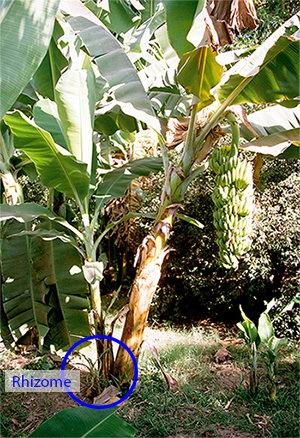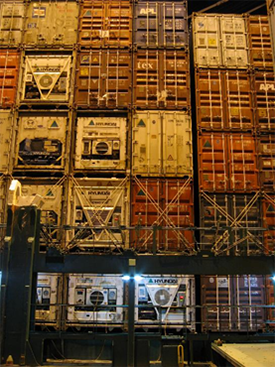InTrans / Jan 28, 2015
The journey of bananas: From land to your hand
Go! Magazine
 posted on January 28, 2015
posted on January 28, 2015
Have you ever wondered what the difference is between a banana and a plantain? Well, the main difference is that a banana is usually eaten raw while a plantain is cooked. Together, they are the fourth largest food crop in the world. In the past 30 years, the demand for bananas alone has grown by 175 percent, which means that the United States population now eats over 6.4 billion pounds of bananas annually.
Bananas and plantains are grown in Central America, Asia, and Africa, where the climate is tropical. But how do those bananas travel from the farm to our local stores in the United States?
As it turns out, this is a pretty complex process. Looking specifically at Costa Rica and one company, Del Monte, in this article, I explore the journey the banana takes from farm to shipping port.
About bananas
Bananas are actually perennial plants, not trees, which means that each banana plant can be cut and replanted, or grown directly from the rhizome, into another banana plant! So neat!

Bananas can’t grow everywhere. They require temperatures around 80 degree Fahrenheit and need between 78 to 98 inches of rainfall to survive. That is why they are readily grown in regions like Costa Rica, Columbia, Peru, and several other countries with tropical climates.
You may be wondering, “Why do they cut bananas when they’re green?” Well, in order to get them to their final destination (us) without rotting, they must be picked early as to not rot during the trip. In order to be “just ripe enough,” the banana only has approximately two weeks from when it’s cut to then be sold at the store.
From the banana plantation to the shipping port
Typically, bananas are grown on large plantations. Plantations include not only a large farm to grow the fruit, but also a building to package, process, and transport to the shipping port.

At the first stage, you have the banana seed that must be planted, and then someone must hand pick the bananas and transport them into the nearby packing shed. From there, workers cut, sort, wash, dry and label the bananas for packing.
Once the bananas are packed, they are put onto a conveyor belt and transported by truck to the nearest container terminal (there are two in Costa Rica). The banana shipment must be kept at a cool temperature at all times to ensure the bananas don’t ripen and then rot. The container terminal can take the banana shipment straight from the truck to the boat. During this time, the bananas are hooked up to electricity to get cool air moving throughout the container bed.
Who helps get the bananas from the farm to “us”?
Bananas travel many miles to get to the US. From Costa Rica to Miami, Florida, a banana travels 1120 miles! It takes a reefer ship about 48 hours to travel that distance.
One of the many people at Del Monte that help get the bananas from the farm to the consumer is a supply chain manager.
Recently, Del Monte has put all of the details about their supply chain into the Cloud***. This way Del Monte can monitor one single system to see the entire network, from producer to local retail. This Cloud allows providers to control the supply and demand of the network (think of when you order something on Amazon and you press “Track Package”). Del Monte’s Cloud network also lets people order, track packages, and—from the provider’s point of view—understand the level of demand (your purchase). A supply chain manager is in charge of this type of work.
If you are interested in this type of dynamic work, you can pursue a bachelor’s degree in supply chain management. This major includes understanding different supply chain management activities (from demand planning to information technology). The average annual salary earnings for a supply chain manager is about $97,125.
It’s not all bananas
Since bananas require tropical conditions, the planting of bananas has often contributed to rainforest deforestation (cutting down trees). In addition, banana planting can lead to heavy pesticide use to keep the pests away from the fruit, which can be harmful to the plantation workers and the environment. Also, a banana plantation takes away a lot of the diversity that was once present in the rainforest, leading to nutrient loss in the soil, among other affects. At the same time, banana production is important to the economic development of developing countries. So the big question is, “How do we balance economic growth with environmental sustainability?”
Did you know?
- Perennial plants are plants that live for two or more years without being replanted. A banana plant is often mistaken as a tree, because, for example, banana plants often grow to more than 25 feet tall. A banana is a perennial because once the plant dies, it is directly replaced by another plant from the same rhizome. A banana plant will mature for about 10-15 months before growing bananas.
- The rhizome is a horizontal stem that comes from the original plant root. It is the underground stem that allows for new banana plants to grow from the original. A banana rhizome can live for hundreds of years!
- The Cloud is a way of using the internet to access important information such as stored files, emails, etc. If you have ever used “Google Drive,” that is a part of the Cloud.
Related links
http://www.bananalink.org.uk/how-bananas-are-grown
http://www.freshdelmonte.com/our-company/business-divisions/operations-and-sales/
http://homeguides.sfgate.com/bananas-perennial-58553.html
By Jackie Nester, Go! Staff Writer